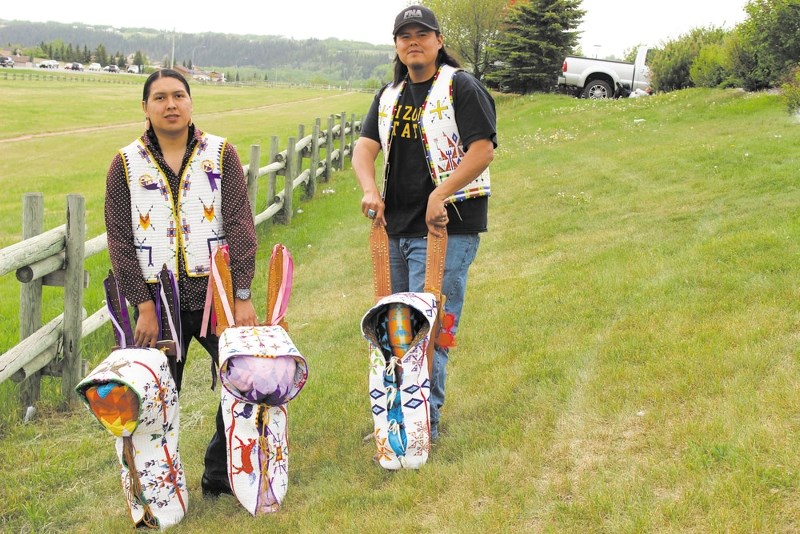Why art? Why beading?
I sat with Cameron Kootenay and Eli Snow in Tim Hortons with coffees in hand.
Kootenay, of the Navajo tribe of New Mexico and the Nakoda tribe in Morley, is a beader and one of the rare silversmiths living in Morley. His designs merge from a combination of his Navajo and Nakoda heritage, resulting in a unique and stunning blend.
Kootenay’s good friend, Snow, is an artisan from Morley who began doing beadwork in 2004. “I started beading because of an unfortunate accident,” he laughs. “My regalia was stolen when I was 16 and I had no choice but to either pay for new regalia or make my own. This accident led to something very good.”
This ‘very good’ thing eventually resulted in Snow’s beadwork being displayed at the 2006 Alberta at the Smithsonian Folklife Festival for two weeks.
The love of beading, however, has gone much deeper than public acknowledgment. Both artists began beading in their teens. Now, over 11 years later, they have designed pieces that reflect not only talent and skill, but an ancient heritage.
“We grew up surrounded by beading.” Kootenay said. “I never thought that I would get into it, but Eli encouraged me. In the past, women were the primary beaders, but male beaders are becoming more common.”
“One of our traditions, pre-euro contact, was trading,” Eli explained. “I completed a man’s outfit last Friday. For this outfit, we made a trade. It’s cool because we’re maintaining that old tradition.”
The two friends, now both family men, are currently working on pieces for their children, which I discovered when I asked about their most meaningful pieces.
“That’s easy,” Kootenay interjected, saying he recently completed a cradleboard for his one-year-old son, Mesa. “To see him sleeping and living in it, it hits home. When you create something for someone you created, you can’t beat it.”
Kootenay implemented his family’s design into the cradleboard for his son, which included a red ring that is Sioux design protocol.
“The red ring that wraps around the cradleboard represents the red road; it’s a good way of life, where you are at peace with yourself and everything around you. And you wish that life for your child.”
I asked about their dream projects. “Every year,” Kootenay said, “my family takes part in the Calgary Stampede as a part of sharing our culture with the world. I would love to make a complete outfit for the horse parade.”
Snow added, “All of it has been done. It’s like when you write a book; the cool thing is that it lasts forever. When I’m gone, the greatest project is that my work will remain in the family.”
One of these projects that will last for generations is a cradleboard that Snow designed for his youngest daughter, Waniyebu.
I then asked the artists about their inspiration. Their response was the accountability and competitive atmosphere of a community of beaders in Morley, who connect and feed off of one another’s energy and creativity. The group provides input and teaches one another.
“It’s a tribute to the old way of life,” Snow said, adding that the men who had been beading for decades encouraged the younger generations to begin creating their own beadwork.
As for international inspiration, Snow acknowledged Emil Hermanyhorses, a curator at the National Indian Museum of Art. “I don’t say this term lightly, but he is a master beader.”
Inspiration comes not only from present artists, but also from the past.
Both men admired the old way of living, a life of tipis and warriors and hunting buffalo.
When they considered their roots, their artwork became more detailed, emphasizing the history from which their artwork pulled its own inspiration.
The Denver and Glenbow Museums both carry artifacts from the past that sing of ancient stories that birthed designs for this beautiful and unique culture.
This culture carries on in families that bead together.
“When I began beading,” Snow said, “I was sitting right beside my wife. I can’t do any of it without my wife. Now we both bead together and we feed off of one another in colour and design. She’s the one who deserves just as much credit as I do.”
Kootenay agreed, telling me that his wife, Jovi, is an incredible beader. “We have created all of our pieces together.”
So, why art? Why beading?
Snow said, “Beading comes at a price and it can’t be measured by money. There’s so much more to it.”
“It’s food for the spirit,” Kootenay continued. “It takes a lot of time and devotion to bead. But beading gives back to you. It brings out the best in everyone. It teaches you.”
Adelle Payne is a summer student with the Cochrane Pregnancy Care Centre. In her position as research assistant, she is assessing housing needs in the Cochrane community, as well as building relationships with artisans in the community of Morley, with a desire to assist those who are marketing their artwork. The Cochrane Pregnancy Care Centre serves communities in the Bow Corridor, including Morley.




